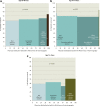Primary Care Providers' Beliefs and Recommendations and Use of Screening Mammography by their Patients
- PMID: 28070772
- PMCID: PMC5377895
- DOI: 10.1007/s11606-016-3973-y
Primary Care Providers' Beliefs and Recommendations and Use of Screening Mammography by their Patients
Abstract
Background: Revised breast cancer screening guidelines have fueled debate about the effectiveness and frequency of screening mammography, encouraging discussion between women and their providers.
Objective: To examine whether primary care providers' (PCPs') beliefs about the effectiveness and frequency of screening mammography are associated with utilization by their patients.
Design: Cross-sectional survey data from PCPs (2014) from three primary care networks affiliated with the Population-based Research Optimizing Screening through Personalized Regimens (PROSPR) consortium, linked with data about their patients' mammography use (2011-2014).
Participants: PCPs (n = 209) and their female patients age 40-89 years without breast cancer (n = 30,233).
Main measures: Outcomes included whether (1) women received a screening mammogram during a 2-year period; and (2) screened women had >1 mammogram during that period, reflecting annual screening. Principal independent variables were PCP beliefs about the effectiveness of mammography and their recommendations for screening frequency.
Key results: Overall 65.2% of women received >1 screening mammogram. For women 40-48 years, mammography use was modestly lower for those cared for by PCPs who believed that screening was ineffective compared with those who believed it was somewhat or very effective (59.1%, 62.3%, and 64.7%; p = 0.019 after controlling for patient characteristics). Of women with PCPs who reported they did not recommend screening before age 50, 48.1% were nonetheless screened. For women age 49-74 years, the vast majority were cared for by providers who believed that screening was effective. Provider recommendations were not associated with screening frequency. For women ≥75 years, those cared for by providers who were uncertain about effectiveness had higher screening use (50.7%) than those cared for by providers who believed it was somewhat effective (42.8%). Patients of providers who did not recommend screening were less likely to be screened than were those whose providers recommended annual screening, yet 37.1% of patients whose providers recommended against screening still received screening.
Conclusions: PCP beliefs about mammography effectiveness and screening recommendations are only modestly associated with use, suggesting other likely influences on patient participation in mammography.
Keywords: mammography; provider beliefs; variation in care.
Conflict of interest statement
The authors declare that they do not have a conflict of interest.
Figures


Comment in
-
Capsule Commentary on Haas et al., Primary Care Providers' Beliefs and Recommendations and Use of Screening Mammography by their Patients.J Gen Intern Med. 2017 Apr;32(4):473. doi: 10.1007/s11606-017-3986-1. J Gen Intern Med. 2017. PMID: 28160186 Free PMC article. No abstract available.
References
MeSH terms
Grants and funding
LinkOut - more resources
Full Text Sources
Other Literature Sources
Medical

